Appendices
A.1. Unit Conversion Factor
| (a) Length | |||
| 1 in | = | 2.54 | cm |
| 1 ft | = | 0.305 | m |
| 1 mi | = | 1.609 | km |
| 1 m | = | 3.281 | ft |
| 1 yd | = | 0.9144 | m |
| 1 km | = | 0.6214 | mi |
| = | 1000 | m | |
| 1 chain | = | 20.11 | m |
| 1 Eng. Ch. | = | 30 | m |
| (b) Area | |||
| 1 sq in | = | 6.452 | sq cm |
| 1 sq ft | = | 0.0929 | sq m |
| 1 sq cm | = | 0.155 | sq in |
| 1 sq m | = | 10.76 | sq ft |
| = | 1.094 | sq yd | |
| 1 ac | = | 0.4047 | ha |
| = | 4047 | sq m | |
| = | 43,560 | sq ft | |
| 1 ha | = | 104 | sq m |
| = | 2.471 | ac | |
| 1 sq mi | = | 2.59 | sq km |
| = | 640 | ac | |
| 1 sq km | = | 100 | ha |
| = | 0.3861 | sq mi | |
| = | 247 | ac | |
| Table Continued | |||

| (c) Volume | |||
| 1 cu ft | = | 28.32 | L |
| = | 6.24 | imp gal | |
| = | 7.48 | US gal | |
| 1 Liter (L) | = | 1000 | cu cm |
| = | 0.22 | imp gal | |
| 1 cu m | = | 35.3147 | cu ft |
| = | 1000 | L | |
| = | 220 | gal | |
| 1 gal | = | 4.546 | L |
| 1 ac-ft | = | 43,560 | cu ft |
| = | 0.1234 | ha-m | |
| = | 1234 | cu m | |
| 1 cu km | = | 0.811 | M ac-ft |
| 1 ha-m | = | 104 | cu m |
| = | 8.14 | ac-ft | |
| = | 0.35315 | MCFT | |
| 1 M cu m | = | 100 | ha-m |
| (1 MCM) | = | 106 | cu m |
| = | 814 | ac-ft | |
| = | 35.3147 | MCFT | |
| (d) Discharge or Flow Rate | |||
| 1 cusec (cfs) | = | 0.02832 | m3/s |
| = | 28.3 | lps | |
| = | 1.983 | ac-ft/day | |
| = | 374.03 | gpm | |
| = | 724 | ac-ft/year | |
| 1 m3/s | = | 35.3147 | cusec (cfs) |
| = | 1000 | lps | |
| 1 cfs | = | 28.3168 | lps |
| Table Continued | |||

| 1 m3/day | = | 2190 | imp gpd |
| 1 ac-ft/day | = | 1233.5 | m3/day |
| (e) Flow Velocity | |||
| 1 ft/s | = | 30.48 | cm/s |
| 1 m/s | = | 3.281 | ft/s |
| 1 mi/h | = | 1.467 | ft/s |
| = | 1.609 | km/h | |
| 1 knot | = | 1.69 | ft/s |
| = | 0.515 | m/s | |
| 1 km/h | = | 1000 | m/h |
| = | 0.2778 | m/s | |
| = | 0.9113 | ft/s | |
| (f) Mass | |||
| 1 kg | = | 2.205 | lb |
| = | 0.06852 | slug | |
| = | 1000 | g | |
| = | 106 | mg | |
| 1 ton | = | 1000 | kg |
| 1 lb | = | 453.6 | g |
| 1 slug | = | 32.2 | lb |
| = | 14.6 | kg | |
| (g) Force (Weight) | |||
| 1 kgf | = | 9.81 | N |
| = | 2.205 | lb | |
| 1 ln | = | 4.448 | N |
| = | 16 | oz | |
| (h) Pressure | |||
| 1 kg/cm3 | = | 14.23 | psi |
| 1 atm | = | 14.7 | psia |
| Table Continued | |||

| = | 34 | ft of water | |
| = | 10.36 | m of water | |
| = | 30 | in of Hg | |
| = | 76 | cm of Hg | |
| = | 101.32 | kN/m2 | |
| = | 1013.2 | mb | |
| 1 bar | = | 105 | N/m2 |
| 1 mb | = | 0.0143 | psi |
| 1 psi | = | 6.895 | kN/m2 |
| = | 0.7031 | m of water | |
| (i) Mass Density | |||
| 1 g/cm3 | = | 1.94 | slugs/ft3 |
| = | 1000 | kg/m3 | |
| 1 slug/ft3 | = | 515.4 | kg/m3 |
| (j) Specific Weight | |||
| 1 g/cm3 | = | 62.4 | pcf |
| 1 pcf | = | 157.1 | N/m3 |
| 1 kgf/m3 | = | 9.81 | N/m3 |
| (k) Dynamic Viscosity | |||
| 1 lb-sec/ft2 | = | 47.88 | N s/m2 |
| = | 478.8 | poise | |
| 1 cP | = | 0.01 | poise |
| 1 N s/m2 | = | 10 | poise |
| 1 kgf s/m2 | = | 9.81 | N s/m2 |
| = | 98.1 | poise | |
| (L) Kinematic Viscosity | |||
| 1 ft2/s | = | 0.093 | m2/s |
| = | 929 | Stokes | |
| 1 m2/s | = | 104 | Stokes |
| 1 centi-Stoke | = | 10−6 | m2/s |
| Table Continued | |||

| (m) Power | |||
| 1 metric HP | = | 75 | m kg/s |
| = | 736 | watts | |
| = | 0.736 | kW | |
| = | 542.8 | ft lb | |
| = | 0.986 | HP | |
| (n) Temperature | |||
| °C | = | (°F − 32) (5/9) | |
| K | = | 273 + °C | |

A.2. (A) Guidelines for Interpretations of Water Quality Parameters for Irrigation (1FAO, 1994)
| Potential Irrigation Problem | Units | Degree of Restriction on Use | |||||
| None | Slight to Moderate | Severe | |||||
| Salinity (Affects Crop Water Availability) | |||||||
| ECw | dS/m | <0.7 | 0.7–3.0 | >3.0 | |||
| (or) | |||||||
| TDS | mg/L | <450 | 450–2000 | >2000 | |||
| Infiltration (Affects Infiltration Rate of Water Into the Soil. Evaluate Using ECw and SAR Together) | |||||||
| SAR | =0–3 | and ECw | = | >0.7 | 0.7–0.2 | <0.2 | |
| =3–6 | = | >1.2 | 1.2–0.3 | <0.3 | |||
| =6–12 | = | >1.9 | 1.9–0.5 | <0.5 | |||
| =12–20 | = | >2.9 | 2.9–1.3 | <1.3 | |||
| =20–40 | = | >5.0 | 5.0–2.9 | <2.9 | |||
| Table Continued | |||||||

| Potential Irrigation Problem | Units | Degree of Restriction on Use | |||||
| None | Slight to Moderate | Severe | |||||
| Specific Ion Toxicity (Affects Sensitive Crops) | |||||||
| Sodium (Na) | |||||||
| Surface irrigation | SAR | <3 | 3–9 | >9 | |||
| Sprinkler irrigation | me/L | <3 | >3 | ||||
| Chloride (Cl) | |||||||
| Surface irrigation | me/L | <4 | 4–10 | >10 | |||
| Sprinkler irrigation | me/L | <3 | >3 | ||||
| Boron (B) | mg/L | <0.7 | 0.7–3.0 | >3.0 | |||
| Miscellaneous Effects (Affects Susceptible Crops) | |||||||
| Nitrogen (NO3- N) | mg/L | <5 | 5–30 | >30 | |||
| Bicarbonate (HCO3) | |||||||
| (overhead sprinkling only) | me/L | <1.5 | 1.5–8.5 | >8.5 | |||
| pH | Normal range 6.5–8.4 | ||||||
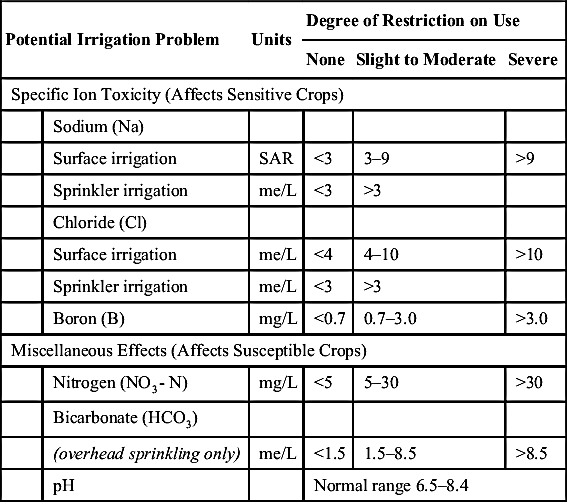
(B) Usual Range of Water Quality Parameters for Irrigation (2FAO, 1994)
| Water Parameter | Symbol | Unit | Usual Range in Irrigation Water | |
| Salinity | ||||
| Salt content | ||||
| Electrical conductivity | ECw | dS/m | 0–3 | dS/m |
| (or) | ||||
| Total dissolved solids | TDS | mg/L | 0–2000 | mg/L |
| Table Continued | ||||
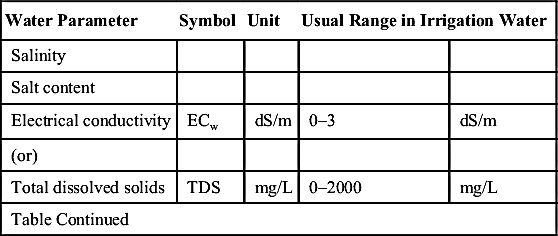
| Water Parameter | Symbol | Unit | Usual Range in Irrigation Water | |
| Cations and anions | ||||
| Calcium | Ca++ | me/L | 0–20 | me/L |
| Magnesium | Mg++ | me/L | 0–5 | me/L |
| Sodium | Na+ | me/L | 0–40 | me/L |
| Carbonate | me/L | 0–0.1 | me/L | |
| Bicarbonate | me/L | 0–10 | me/L | |
| Chloride | Cl− | me/L | 0–30 | me/L |
| Sulfate | me/L | 0–20 | me/L | |
| Nutrients | ||||
| Nitrate-nitrogen | NO3-N | mg/L | 0–10 | mg/L |
| Ammonium-nitrogen | NH4-N | mg/L | 0–5 | mg/L |
| Phosphate-phosphorus | PO4-P | mg/L | 0–2 | mg/L |
| Potassium | K+ | mg/L | 0–2 | mg/L |
| Miscellaneous | ||||
| Boron | B | mg/L | 0–2 | mg/L |
| Acid/basicity | pH | 1–14 | 6.0–8.5 | |
| Sodium adsorption ratio | SAR | me/L | 0–15 | |
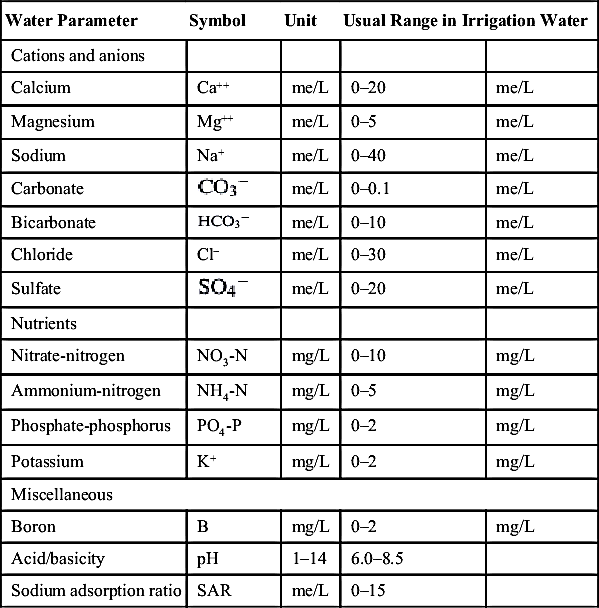
A.3. FORTRAN Program for Mann–Kendal Test
$DEBUG
C PRGRAMME FOR IDENTIFICATION OF TREND USIN MANN KENDALLS TEST
C WHEN SERIES IS AUTOCORRELETED. IN THIS APPROACH THE TIME SERIES
C IS NORMALIZED USING THE LAG-1 AUTO CORRELATION FUNCTION OF TIME SERIES
DIMENSION X(100,1000),TITLE (80),x1(1000),Y1(1000)
DIMENSION R(50),RKL(50),RKU(50)
OPEN(UNIT=1,FILE=‘Rainfall.IN’,STATUS=‘OLD’)
OPEN(UNIT=2,FILE=‘Surwania_Rainfall_MK_ACF.OUT’)
OPEN(UNIT=3,FILE=‘Surwania_Rainfall_MK_ACF_SUMMARY.OUT’)
READ(1,1)TITLE
1 FORMAT(80A1)
C N IS TOTAL NO. OF DATA POINTS IN THE SERIES.
read(1,∗)m,n
c READ(1,∗)N
C X IS THE INPUT SERIES.
do j=1,n
READ(1,∗)(X(I,j),i=1,m)
enddo
C
do j=1,n
WRITE(2,2)(X(I,j),i=1,m)
enddo
C
2 FORMAT(1X,(2X,10F7.1))
WRITE(∗,∗)‘SUMMARY OF TREND ANALYSIS USING MANN KENDALL TEST’
WRITE(∗,∗)‘=========================================’
WRITE(∗,∗)
WRITE(∗,∗)‘NO. OF TIME SERIES =’,M
WRITE(∗,∗)‘NO. OF OBSERVATIONS =’,N
WRITE(∗,∗)
WRITE(∗,∗)‘---------------------------------’
WRITE(∗,∗)‘I RKL(1) R(1) RKU(1) ICODE Z COMMENT’
WRITE(∗,∗)‘---------------------------------’
WRITE(3,∗)‘SUMMARY OF TREND ANALYSIS USING MANN KENDALL TEST’
WRITE(3,∗)‘=========================================’
WRITE(3,∗)
WRITE(3,∗)‘NO. OF TIME SERIES =’,M
WRITE(3,∗)‘NO. OF OBSERVATIONS =’,N
WRITE(3,∗)
WRITE(3,∗)‘---------------------------------’
WRITE(3,∗)‘I RKL(1) R(1) RKU(1) ICODE Z COMMENT’
WRITE(3,∗)‘---------------------------------’
do i=1,m
WRITE(2,∗)‘∗∗∗∗∗∗∗∗∗∗∗∗∗∗∗∗∗∗∗∗∗∗∗∗∗∗∗∗∗∗∗∗∗∗∗∗∗∗∗∗∗∗∗∗∗∗∗’
WRITE(2,∗)‘CLIMATIC SERIES=’,I
WRITE(2,∗)‘∗∗∗∗∗∗∗∗∗∗∗∗∗∗∗∗∗∗∗∗∗∗∗∗∗∗∗∗∗∗∗∗∗∗∗∗∗∗∗∗∗∗∗∗∗∗’
do j=1,n
x1(j)=x(i,j)
enddo
CALL ACF(N,X1,R,RKL,RKU)
DO J=1,N-1
Y1(J)=X1(J+1)-R(1)∗X1(J)
ENDDO
IF (R(1).LT.RKL(1).OR.R(1).GT.RKU(1))THEN
ICODE=2 !R1 IS SIGNIFICANT
call mann kendal(n,Y1,ns,vars,z,np,nl,ntie)
ICODE_T=‘NO’
ELSE
ICODE_T=‘YES’
ENDIF
WRITE(∗,4)I,RKL(1),R(1),RKU(1),ICODE,Z,ICODE_T
WRITE(3,4)I,RKL(1),R(1),RKU(1),ICODE,Z,ICODE_T
ELSE
ICODE=1 !R1 IS NOT SIGNIFICANT
CALL MANN KENDAL(N,X1,NS,VARS,Z,NP,NL,NTIE)
IF(ABS(Z).LE.1.96)THEN
ICODE_T=‘NO’
ELSE
ICODE_T=‘YES’
ENDIF
WRITE(∗,4)I,RKL(1),R(1),RKU(1),ICODE,Z,ICODE_T
WRITE(3,4)I,RKL(1),R(1),RKU(1),ICODE,Z,ICODE_T
ENDIF
ENDDO
4 FORMAT(1X,I3,3X,F5.3,2X,F5.3,2X,F5.3,6X,I1,1X,F8.3,3X,A5)
WRITE(∗,∗)‘---------------------------------’
WRITE(3,∗)‘---------------------------------’
stop
end
subroutine mann kendal(n,x,ns,vars,z,np,nl,ntie)
dimension X(1000)
NP=0
NL=0
NTIE=0
DO 51 I=1,N
J=I+1
NT=1
DO 52 I1=J,N
IF(X(I1).GT.X(I))NP=NP+1
IF(X(I1).EQ.X(I))THEN
NT=NT+1
WRITE(2,∗)‘XI=’,X(I1)
ELSE
IF(X(I1).LT.X(I))NL=NL+1
ENDIF
52 CONTINUE
NTIE=NTIE+NT∗(NT-1)∗(2∗NT+5)
51 CONTINUE
NS=(NP-NL)
VARS=(N∗(N-1)∗(2∗N+5)-NTIE)/18
IF(NS.GT.0) THEN
ELSEIF(NS.LT.0)THEN
Z=(NS+1)/SQRT(VARS)
ELSE
Z=0
ENDIF
WRITE(2,13)n,NTIE,VARS
13 FORMAT(‘no. of observations=’i4/’ VALUE OF TIE=‘I5/’
1VAR(S)=‘F15.5)
WRITE(2,3)NS,Z
3 FORMAT(‘ VALUE OF S=‘I5/’ TEST STATISTICS=’F10.5)
IF(Z.LT.-1.96)WRITE(2,4)
IF(Z.GE.1.96)WRITE(2,5)
IF(ABS(Z).LT.1.96)WRITE(2,6)
4 FORMAT(‘ THERE IS FALLING TREND IN DATA AT 5% SIGNIFICANCE 1LEVEL’)
5 FORMAT(‘ THERE IS RISING TREND IN DATA AT 5% SIGNIFICANCE 1LEVEL’)
6 FORMAT(‘ THERE IS NO TREND IN DATA AT 5% SIGNIFICANCE LEVEL’)
c write(2,7)(x(i),i=1,n)
7 format(f8.1)
return
END
C PROGRAM TO COMPUTE THE AUTO-CORRELATION FUNCTION
C PROGRAM IS BASED ON THE EQUATION GIVEN BY SALAS ET.AL.(1988)
C PROGRAM WRITTEN BY R.K.RAI
C
SUBROUTINE ACF(N,X,R,RKL,RKU)
DIMENSION X(500),Y(500),R(50),RKL(50),RKU(50)
K=N/2
C
WRITE(2,∗)‘--------------------------------’
WRITE(2,∗)‘LAG(K) LOWER LIMIT R(K) UPPER LIMIT’
WRITE(2,∗)‘--------------------------------’
DO KK=1,K
SUMX=0.0
SUMY=0.0
SUMX2=0.0
SUMY2=0.0
SUMXY=0.0
NK=N-KK
DO J=1,N-KK
Y(J)=X(J+KK)
SUMY=SUMY+Y(J)
SUMX=SUMX+X(J)
DO J=1,N-KK
SUMX2=SUMX2+(X(J)-SUMX/NK)∗(X(J)-SUMX/NK)
SUMY2=SUMY2+(Y(J)-SUMY/NK)∗(Y(J)-SUMY/NK)
SUMXY=SUMXY+((X(J)-SUMX/NK)∗(Y(J)-SUMY/NK))
ENDDO
RKL(KK)=(-1-1.645∗SQRT(N-KK-1.))/(N-KK)
R(KK)=SUMXY/(SQRT(SUMX2)∗SQRT(SUMY2))
RKU(KK)=(-1+1.645∗SQRT(N-KK-1.))/(N-KK)
WRITE(2,4)KK,RKL(KK),R(KK),RKU(KK)
ENDDO
4 FORMAT(1X,I3,1X,F8.3,1X,F8.3,1X,F8.3)
WRITE(2,∗)‘--------------------------------’
RETURN
END
A.4. Guidelines for Selecting the Design Floods (3CBIP, 1989)

A.5. Computation of Design Flood for Medium to Small Irrigation Project: Unit Hydrograph Technique
Design of any hydrologic project including irrigation projects, requires estimation of design flood. For estimating the design flood followed by fixing the capacity of the spillway, generally three types of design storms are used: (1) standard project storm (SPS), (2) probable maximum storm or probable maximum precipitation (PMP), and (3) frequency-based storms (FBS).
The SPS is the most severe rainstorm that has actually occurred over a watershed during the period of available records. It is used in the design of all water resources projects where much risk is not involved and economic considerations are taken into account. The SPS is used for design of medium irrigation or water resources projects.
The PMP is defined as the greatest depth of precipitation for a given period which is physically possible over a particular area and geographical location at a certain time of year. PMP is required to estimate the probable maximum flood, used in the design of spillways for large dams including major water resources or irrigation projects. The PMP can be estimated either by statistical methods or by the physical method in which historical rainstorms are maximized. It is generally determined from the greatest rainfall depth associated with severe rainstorm (i.e., SPS).
In FBS, a design flood can be estimated using flood-frequency analysis or frequency analysis of runoff obtained from the maximum rainfall–runoff analysis. The former involves a frequency analysis of long-term streamflow data at a site of interest. The latter involves either the frequency analysis of rainfall followed by rainfall–runoff analysis or frequency analysis of peak runoff estimated from maximum rainfall–peak runoff analysis.
Here, the appendix presents an SPS-based design flood estimation followed by fixing the spillway capacity. The procedure for estimating the design flood is as follows:
1. Determine the most severe rainfall storm (SPS) using the historical data. In India, it can be obtained by a written request to the India Meteorological Department (IMD) for a particular geographical location of interest.
2. Determine the short-term temporal distribution of the SPS: Using the SRRG data, average temporal distribution can be determined, and the same will be used in the determination of temporal distribution of SPS. The same may be requested from the IMD.
3. Determine the rainfall hyetograph (i.e., rainfall intensity vs. time graph and table).
4. Use the constant abstraction rate of the storm (i.e., phi-index), and determine the excess rainfall intensity followed by rainfall excess.
5. Use the derived unit hydrograph (UH) of particular duration for the given catchment.
6. Develop a critical sequence of the rainfall excess using the coordinate of the UH. For arriving at the critical sequences, the following steps are involved:
a. The ordinates of the design UH are written in a column.
b. The highest rainfall excess is written against the peak ordinate of the design UH. The second highest rainfall excess ordinate is written against the second highest ordinate of the UH, which is next to the peak ordinate, and so on. If all the ordinates of UHs are not covered by the rainfall excesses, zeros are put against them.
c. The column of the rainfall excess sequence so generated in step (b) is reversed, i.e., the last value of the rainfall excess is put as the first, the “last but one” is written at the place of the second, and so on. This arrangement of the rainfall excesses is called the “critical sequences.”
7. This critical sequenced rainfall excess is convoluted with design UH to arrive at the design flood.
Example A5.1: Estimate the design flood for a medium irrigation project having catchment area of 256 sq km corresponding to the recorded standard project storm (SPS) of 53.3 cm in 48 h. The distribution of rainfall and 2-h UH ordinates are given as under:
| Time (h) | 0 | 2 | 4 | 6 | 8 | 10 | 12 | 14 | 16 | 18 | 20 | 22 | 24 |
| %Rainfall | 0 | 21.0 | 30.75 | 39.5 | 45.25 | 51.5 | 56.0 | 59.75 | 64.4 | 68.0 | 71.25 | 74.5 | 77.0 |
| Time (h) | 26 | 28 | 30 | 32 | 34 | 36 | 38 | 40 | 42 | 44 | 46 | 48 | |
| %Rainfall | 79.25 | 81.75 | 83.75 | 86.0 | 88.0 | 90.0 | 91.5 | 93.5 | 95.25 | 97.0 | 99.0 | 100.0 |

Assume phi-index value of 0.10 cm/h and base flow of 34.0 m3/s.
Solution:
(i) Temporal distribution of SPS and excess rainfall estimation
| Time (h) | 48-h Rainfall Distribution (%) | Cumulative Rainfall (cm) | Incremental Rainfall (cm) | Rainfall Intensity (cm/h) | Phi-Index (cm/h) | Excess Rainfall Intensity (cm/h) | Excess Rainfall Depth (cm) |
| (i) | (ii) | (iii) | (iv) | (v) | (vi) | (vii) | (viii) |
| 0 | 0 | 0 | 0 | 0.00 | 0.1 | 0.00 | 0.00 |
| 2 | 21 | 11.19 | 11.19 | 5.60 | 0.1 | 5.50 | 11.00 |
| 4 | 30.75 | 16.39 | 5.2 | 2.60 | 0.1 | 2.50 | 5.00 |
| 6 | 39.5 | 21.05 | 4.66 | 2.33 | 0.1 | 2.23 | 4.46 |
| 8 | 45.25 | 24.12 | 3.07 | 1.54 | 0.1 | 1.44 | 2.88 |
| 10 | 51.5 | 27.45 | 3.33 | 1.67 | 0.1 | 1.57 | 3.14 |
| 12 | 56 | 29.85 | 2.4 | 1.20 | 0.1 | 1.10 | 2.20 |
| 14 | 59.75 | 31.85 | 2 | 1.00 | 0.1 | 0.90 | 1.80 |
| 16 | 64.4 | 34.33 | 2.48 | 1.24 | 0.1 | 1.14 | 2.28 |
| 18 | 68 | 36.24 | 1.91 | 0.96 | 0.1 | 0.86 | 1.72 |
| 20 | 71.25 | 37.98 | 1.74 | 0.87 | 0.1 | 0.77 | 1.54 |
| 22 | 74.5 | 39.71 | 1.73 | 0.87 | 0.1 | 0.77 | 1.54 |
| 24 | 77 | 41.04 | 1.33 | 0.66 | 0.1 | 0.56 | 1.12 |
| 26 | 79.25 | 42.24 | 1.2 | 0.60 | 0.1 | 0.50 | 1.00 |
| 28 | 81.75 | 43.57 | 1.33 | 0.66 | 0.1 | 0.56 | 1.12 |
| 30 | 83.75 | 44.64 | 1.07 | 0.54 | 0.1 | 0.44 | 0.88 |
| 32 | 86 | 45.84 | 1.2 | 0.60 | 0.1 | 0.50 | 1.00 |
| 34 | 88 | 46.9 | 1.06 | 0.53 | 0.1 | 0.43 | 0.86 |
| 36 | 90 | 47.97 | 1.07 | 0.54 | 0.1 | 0.44 | 0.88 |
| 38 | 91.5 | 48.77 | 0.8 | 0.40 | 0.1 | 0.30 | 0.60 |
| Table Continued | |||||||

| Time (h) | 48-h Rainfall Distribution (%) | Cumulative Rainfall (cm) | Incremental Rainfall (cm) | Rainfall Intensity (cm/h) | Phi-Index (cm/h) | Excess Rainfall Intensity (cm/h) | Excess Rainfall Depth (cm) |
| (i) | (ii) | (iii) | (iv) | (v) | (vi) | (vii) | (viii) |
| 40 | 93.5 | 49.84 | 1.07 | 0.54 | 0.1 | 0.44 | 0.88 |
| 42 | 95.25 | 50.77 | 0.93 | 0.47 | 0.1 | 0.37 | 0.74 |
| 44 | 97 | 51.7 | 0.93 | 0.47 | 0.1 | 0.37 | 0.74 |
| 46 | 99 | 52.77 | 1.07 | 0.54 | 0.1 | 0.44 | 0.88 |
| 48 | 100 | 53.3 | 0.53 | 0.26 | 0.1 | 0.16 | 0.32 |

(ii) Critical sequencing of rainfall
| Time (h) | 2-h UH (m3/s/cm) | Rainfall Excess (cm) | Sequencing | Critical Sequencing of Excess Rainfall (cm) |
| (i) | (ii) | (iii) | (iv) | (v) |
| 0 | 0 | 0.00 | 0.00 | 1.8 |
| 2 | 6.69 | 11.00 | 2.28 | 2.2 |
| 4 | 22.3 | 5.00 | 2.88 | 2.34 |
| 6 | 83.61 | 4.46 | 4.46 | 3.14 |
| 8 | 178.73 | 2.88 | 11.0 | 5.0 |
| 10 | 84.73 | 3.14 | 5.0 | 11.0 |
| 12 | 33.45 | 2.20 | 3.14 | 4.46 |
| 14 | 16.17 | 1.80 | 2.34 | 2.88 |
| 16 | 6 | 2.28 | 2.2 | 2.28 |
| 18 | 0 | 1.72 | 1.8 | |
| 20 | 1.54 | 0 | ||
| 22 | 1.54 | 0 | ||
| 24 | 2.34 | 0 | ||
| 26 | 1.12 | 0 | ||
| 28 | 0.88 | 0 | ||
| 30 | 1.00 | 0 | ||
| 32 | 0.86 | 0 | ||
| 34 | 0.88 | 0 | ||
| 36 | 0.60 | 0 | ||
| Table Continued | ||||
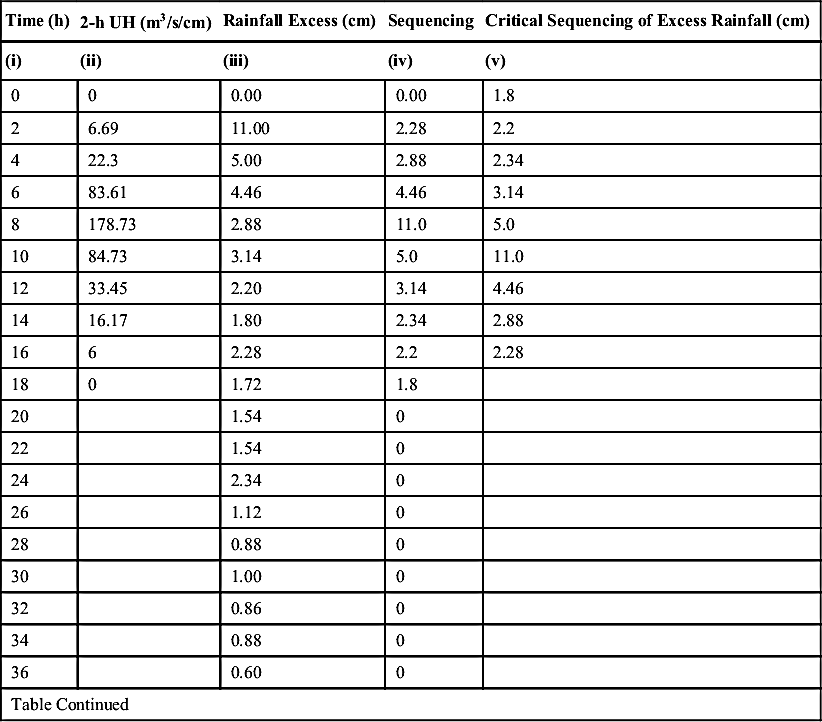
| Time (h) | 2-h UH (m3/s/cm) | Rainfall Excess (cm) | Sequencing | Critical Sequencing of Excess Rainfall (cm) |
| (i) | (ii) | (iii) | (iv) | (v) |
| 38 | 0.88 | 0 | ||
| 40 | 0.74 | 0 | ||
| 42 | 0.74 | 0 | ||
| 44 | 0.88 | 0 | ||
| 46 | 0.32 | 0 | ||
| 48 | 0.00 | 0 |

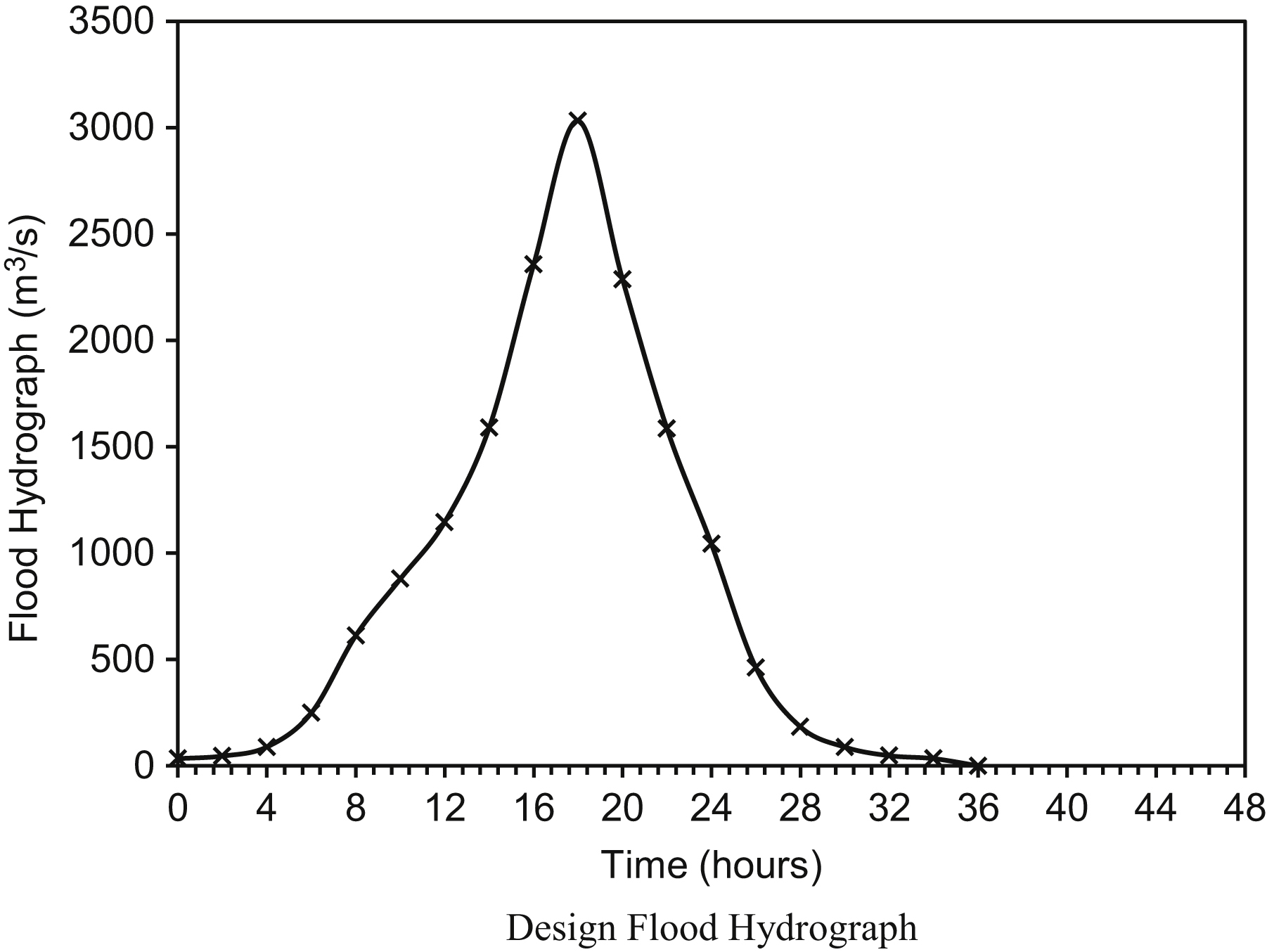
(iii) Determination of design flood hydrograph
| Time (h) | 2-h UH (m3/s/cm) | Direct Runoff From Incremental Excess Rainfall Depth (D), cm | Total DRH (m3/s) | Base Flow (m3/s) | Total Runoff (m3/s) | ||||||||
| D1 = 1.8 | D2 = 2.2 | D3 = 2.34 | D4 = 3.14 | D5 = 5.0 | D6 = 11.0 | D7 = 4.46 | D8 = 2.88 | D9 = 2.28 | |||||
| 0 | 0 | 0.00 | 0.00 | 34.00 | 34.00 | ||||||||
| 2 | 6.69 | 12.04 | 0.00 | 12.04 | 34.00 | 46.04 | |||||||
| 4 | 22.3 | 40.14 | 14.72 | 0.00 | 54.86 | 34.00 | 88.86 | ||||||
| 6 | 83.61 | 150.50 | 49.06 | 15.65 | 0.00 | 215.21 | 34.00 | 249.21 | |||||
| 8 | 178.73 | 321.71 | 183.94 | 52.18 | 21.01 | 0.00 | 578.84 | 34.00 | 612.84 | ||||
| Table Continued | |||||||||||||

| Time (h) | 2-h UH (m3/s/cm) | Direct Runoff From Incremental Excess Rainfall Depth (D), cm | Total DRH (m3/s) | Base Flow (m3/s) | Total Runoff (m3/s) | ||||||||
| D1 = 1.8 | D2 = 2.2 | D3 = 2.34 | D4 = 3.14 | D5 = 5.0 | D6 = 11.0 | D7 = 4.46 | D8 = 2.88 | D9 = 2.28 | |||||
| 10 | 84.73 | 152.51 | 393.21 | 195.65 | 70.02 | 33.45 | 0.00 | 844.84 | 34.00 | 878.84 | |||
| 12 | 33.45 | 60.21 | 186.41 | 418.23 | 262.54 | 111.50 | 73.59 | 0.00 | 1112.47 | 34.00 | 1146.47 | ||
| 14 | 16.17 | 29.11 | 73.59 | 198.27 | 561.21 | 418.05 | 245.30 | 29.84 | 0.00 | 1555.36 | 34.00 | 1589.36 | |
| 16 | 6 | 10.80 | 35.57 | 78.27 | 266.05 | 893.65 | 919.71 | 99.46 | 19.27 | 0.00 | 2322.78 | 34.00 | 2356.78 |
| 18 | 0 | 0.00 | 13.20 | 37.84 | 105.03 | 423.65 | 1966.03 | 372.90 | 64.22 | 15.25 | 2998.13 | 34.00 | 3032.13 |
| 20 | 0.00 | 14.04 | 50.77 | 167.25 | 932.03 | 797.14 | 240.80 | 50.84 | 2252.87 | 34.00 | 2286.87 | ||
| 22 | 0.00 | 18.84 | 80.85 | 367.95 | 377.90 | 514.74 | 190.63 | 1550.91 | 34.00 | 1584.91 | |||
| 24 | 0.00 | 30.00 | 177.87 | 149.19 | 244.02 | 407.50 | 1008.58 | 34.00 | 1042.58 | ||||
| 26 | 0.00 | 66.00 | 72.12 | 96.34 | 193.18 | 427.64 | 34.00 | 461.64 | |||||
| 28 | 0.00 | 26.76 | 46.57 | 76.27 | 149.60 | 34.00 | 183.60 | ||||||
| 30 | 0.00 | 17.28 | 36.87 | 54.15 | 34.00 | 88.15 | |||||||
| 32 | 0.00 | 13.68 | 13.68 | 34.00 | 47.68 | ||||||||
| 34 | 0.00 | 0.00 | 34.00 | 34.00 | |||||||||
| 36 | 0.00 | 34.00 | 0.00 | ||||||||||
| 38 | |||||||||||||
| 40 | |||||||||||||
| 42 | |||||||||||||
| 44 | |||||||||||||
| 46 | |||||||||||||
| 48 | |||||||||||||
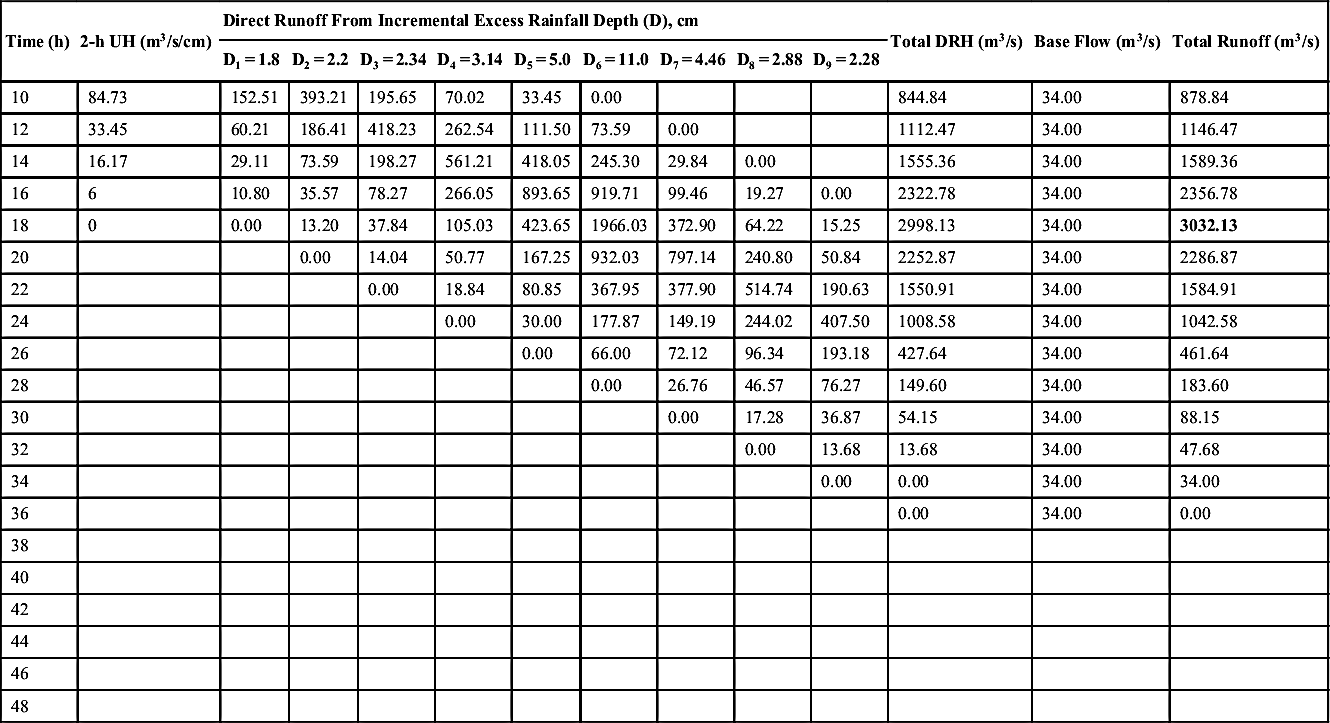
A.6. Computation of Design Flood for Microirrigation Projects: SCS-CN Method
This method is based on the Soil Conservation Services—Curve Number (SCS-CN) technique (4SCS, 1985) through which the designed value of runoff depth is estimated to correspond to design rainfall. The designed rainfall storm corresponds to the daily maximum rainfall of 25–40 years of return period. Once the designed rainfall storm is estimated, the design runoff depth can be computed using the following formula:
 (A6.1)
(A6.1)where Rd is the design value of runoff depth (mm), Pd is the design rainfall depth (mm), S is the maximum potential abstraction (mm), and λ is the abstraction coefficient. The value of λ ranges between 0.1 and 0.3. For black soil, λ = 0.1 for antecedent moisture condition (AMC)-II- and AMC-III-type conditions, and λ = 0.3 for AMC I condition. Since parameter S, i.e., maximum potential abstraction, can vary in the range of 0 ≤ S ≤ ∞, it is mapped onto a dimensionless curve number (CN), varying in a more appealing range 0 ≤ CN ≤ 100, as follows:
Although CN theoretically varies from 0 to 100, the practical design values validated by experience lie in the range (40, 98). The value of CN tabulated in Appendix A.8 corresponds to the hydrological soil group, AMC condition, and land use.
Once the value of Rd is determined from Eq. (A6.1), the peak discharge or designed discharge can be estimated using the following relationship:
where Qp is the designed discharge (m3/s), A is the catchment area (sq km), Rd is the design runoff depth (cm), and tp is the time to peak of the catchment (h).
The value of tp for small catchment can be determined using the following formula:
where tp is the time to peak (h) and tc is the time of concentration (h). The value of tc can be determined by using the Kirpich formula:
where tc is in min, L is the length of the channel from headwater to the outlet (m), and S is the slope (m/m).
Another formula for relating the peak discharge rate with the runoff depth and time to peak, generally used in southern India is5:
The value of tp (h) can be determined by using the following relationships:
 (A6.7)
(A6.7)Example A6.1: Estimate the design discharge for a microirrigation project having a catchment area of 25 sq km with a length:width (L:W) ratio of 6. The daily maximum rainfall for 25 years return period is 150 mm. The soil group of the catchment is red soil. The land uses are:
Cultivated land with crops is 60% and waste land is 40%.
Solution:
Catchment area, A = 25 sq km; L:W = 5
Hydrological soil group = red soil (Group B)
(ii) Computation of CN for hydrological soil group B:
| S. No. | Land Uses | %Area | CN | Weighted CN |
| 1 | Cultivated land with crops | 60.0 | 75 | 45 |
| 2 | Waste land | 40.0 | 80 | 32 |
| 100 | Weighted CN | 77 |

The value of maximum potential abstraction, S will be:
(iii) Determined design runoff depth for Pd = 150 mm assuming λ = 0.3

(iv) Determine the designed discharge using Eq. (A6.3)
A.7. Computation of Design Flood: Statistical Distribution Used in Frequency Analysis
There are various statistical distributions, which can be applied in frequency analysis of hydrologic data. The commonly used distribution functions and the best way of use are as follows. The details of these distribution functions can be found in Singh (1998) and Rao and Hamed (2000).
1. Normal Distribution
Normal distribution is used in frequency analysis for fitting empirical distributions to hydrological data, and in simulation of data. As many statistical parameters are approximately normally distributed, the normal distribution is often used for statistical inferences.
The probability density function:
 (A7.1)
(A7.1)where μ and σ are the parameters. The standard normal variate u is the normal variable with a mean of 0 and standard deviation equal to 1. Thus the pdf in normal variate form will be:
 (A7.2)
(A7.2)where u = (x – μ)/σ. The f(u) function can be numerically estimated using the relation given by Abramowitz and Stegun (1965) as:
where
 (A7.4)
(A7.4)The cumulative distribution of normal variate is given by:
A numerical approximation of Eq. (A7.5) given by Abramowitz and Stegun (1965) is:
where
 (A7.8)
(A7.8)Parameter estimation:
Quantile estimate:
For a given return period T, the corresponding probability of nonexceedance is F = 1 − 1/T. It is easy to calculate the standard normal variate u corresponding to a probability F of nonexceedence. Abramowitz and Stegun (1965) gave the value of u corresponding to the probability of exceedence P as follows:
where
and
 (A7.14)
(A7.14)When P > .5, the required value of u is taken as opposite sign of the estimated value.
Chow (1964) proposed the following general form of the quantile estimate formula:
where KT is the frequency factor, which is a function of the return period and the parameters of the distribution. For normal distribution, the required quantile estimate is calculated using the following relationship:
Standard error of estimate
 (A7.17)
(A7.17)Confidence interval:
An approximate (1 − α) confidence interval for  is given by:
is given by:
where α is the significance level. For 5% significance level (i.e., 95% confidence level) Zα/2 = 1.96. For 90% and 99% confidence interval, the values of Zα/2 are 1.645 and 2.575, respectively.
2. Log-Normal Distribution
Parameters of the log-normal distribution using MoM and PWM are estimated, and are related to their sample moments and L-moments as follows:
 (A7.20a,b)
(A7.20a,b)where
Quantile estimates: The flood quantile is estimated using the following relationship:
In the form of frequency factor, Eq. (A7.23) can be written as follows:
with
 (A7.25)
(A7.25)where  and
and  are the mean and standard deviation of the original series.
are the mean and standard deviation of the original series.
Standard error:
The standard error while using the MoM as parameter estimator is estimated using the following expression:
with
and
 (A7.27b)
(A7.27b)3. Two-Parameter Gamma Distribution
It is a widely used distribution function in hydrology. In many cases, event-based hydrographs, monthly rainfall, etc., follow gamma distribution. The pdf and cdf of the gamma distribution are expressed as follows:
Substituting  , we get the following form of the cdf:
, we get the following form of the cdf:
Parameter estimation:
with
 (A7.33)
(A7.33)The skewness coefficient is given by:
PWM: Hosking (1990) gave the following relationships for estimating the parameters α and β using the probability weighted moments.
If 0 < t < ½, where t = l2/l1, then z = πt2 and
If  then z = 1 − t and
then z = 1 − t and
Quantile estimates: Kite (1977) shows that the frequency factor KT for the two-parameter gamma distribution is:
where  and χ2 can be obtained using the following relation:
and χ2 can be obtained using the following relation:
 (A7.39)
(A7.39)where u is the standard normal variate corresponding to a probability of nonexceedance of  ; ν is the degree of freedom = 2β. Several expressions for estimating KT directly from Cs are suggested by Bobée and Ashkar (1991). The approximation suggested by Wilson and Hilferty (1931), known as Wilson–Hilferty transformation, can be used, which is expressed as follows:
; ν is the degree of freedom = 2β. Several expressions for estimating KT directly from Cs are suggested by Bobée and Ashkar (1991). The approximation suggested by Wilson and Hilferty (1931), known as Wilson–Hilferty transformation, can be used, which is expressed as follows:
For Cs ≤ 1.0 up to Cs = 2:
 (A7.40)
(A7.40)The T-year quantile is then estimated using the following expression:
Standard error: While using the MoM for parameter estimation the standard error of estimate in the quantile can be estimated using the following formula:
 (A7.42)
(A7.42)where Cv is the coefficient of variation and KT is the frequency factor. The term  is calculated from the Wilson–Hilferty transformation formula for KT by taking the partial differentiation with respect to Cs and is given as follows:
is calculated from the Wilson–Hilferty transformation formula for KT by taking the partial differentiation with respect to Cs and is given as follows:
 (A7.43)
(A7.43)The confidence interval can be calculated similar to the normal distribution.
4. Pearson (3) Distribution
The pdf and cdf of the Pearson (3) distribution are given by:
 (A7.44)
(A7.44)where
The cdf is:
 (A7.47)
(A7.47) (A7.48)
(A7.48)Parameter estimation
PWM: For t3 > 1/3, let tm = 1 − t3 then
 (A7.52)
(A7.52)For t3 < 1/3, let  then
then
 (A7.54)
(A7.54)Quantile estimate:
The flood quantile is estimated using the following formula:
where KT is the frequency factor corresponding to a return period of T years and can be calculated using the steps similar to those involved in the gamma distribution.
Standard error: While using the MoM for parameter estimation the standard error of estimate in the quantile can be estimated using the following formula:
 (A7.57)
(A7.57)5. Log-Pearson (3) Distribution
The easy way of fitting the log-Pearson [LP (3)] distribution is to take the logarithm of the variable and follow the similar steps mentioned in case of Pearson (3) distribution. The flood quantile is estimated using the following expression:
The LP (3) distribution is also recommended by the US Water Resources Council for flood-frequency analysis related to federal projects (USWRC, 1967, 1976, 1977, 1981).
6. Extreme Value Type I Distribution (Gumbel Distribution)
The extreme value type I is most commonly used distribution function applied in flood-frequency analysis of annual maximum flow series. It is also known as the Gumbel distribution. The pdf and cdf of this distribution are expressed by Eqs. (A7.59) and (A7.60), respectively.
Parameter estimation: Parameters α and β are related with sample moments and L-moments ratios in case of MoM and PWM methods, respectively.
MoM:
PWM:
Quantile estimate:
The T-year flood quantile is estimated using the following formula:
Standard error:
where
7. Generalized Extreme Value Distribution
 (A7.69)
(A7.69) (A7.70)
(A7.70)Parameter estimation:
MoM:
For k > 0 (−2 < Cs < 1.14), R2 = 1
 (A7.71)
(A7.71)For k < 0 (−10 < Cs < 0) R2 = 0.99998
PWM:
where
 (A7.77)
(A7.77)Quantile estimate: The flood quantile are estimated using the following relationship:
 (A7.79)
(A7.79)A.8. Soil Conservation Services (SCS)–Curve Number (CN) Values (6SCS, 1985)
| S. No. | Land Use Description/Treatment | Hydrologic Condition/% Impervious Area | Hydrologic Soil Groups | |||
| A | B | C | D | |||
| Urban | ||||||
| 1 | Residential: | |||||
| Average lot size:1/8 acre or less | 65 | 77 | 85 | 90 | 92 | |
| 1/4 acre | 38 | 61 | 75 | 83 | 87 | |
| 1/3 acre | 30 | 57 | 72 | 81 | 86 | |
| 1/2 acre | 25 | 54 | 70 | 80 | 85 | |
| 1 acre | 20 | 51 | 68 | 79 | 84 | |
| 2 acre | 12 | 46 | 65 | 77 | 82 | |
| 2 | Paved parking lots, roofs, driveways, etc. (excluding right-of-way) | 98 | 98 | 98 | 98 | |
| 3 | Streets and roads: | |||||
| Paved with curbs and storm sewers (excluding right-of-way) | 98 | 98 | 98 | 98 | ||
| Paved, open ditches (including right-of-way) | 82 | 89 | 92 | 93 | ||
| Gravel (including right-of-way) | 76 | 85 | 89 | 91 | ||
| Dirt (including right-of-way) | 72 | 82 | 87 | 89 | ||
| 4 | Western desert areas: | |||||
| Natural desert landscaping (pervious areas only) | 63 | 77 | 85 | 88 | ||
| Artificial desert landscaping (impervious weed barrier, desert shrub with 1- to 2-inch sand or gravel mulch and basin borders) | 96 | 96 | 96 | 96 | ||
| 5 | Urban districts: | |||||
| Commercial and business areas | 85 | 89 | 92 | 94 | 95 | |
| Industrial districts | 72 | 81 | 88 | 91 | 93 | |
| Table Continued | ||||||
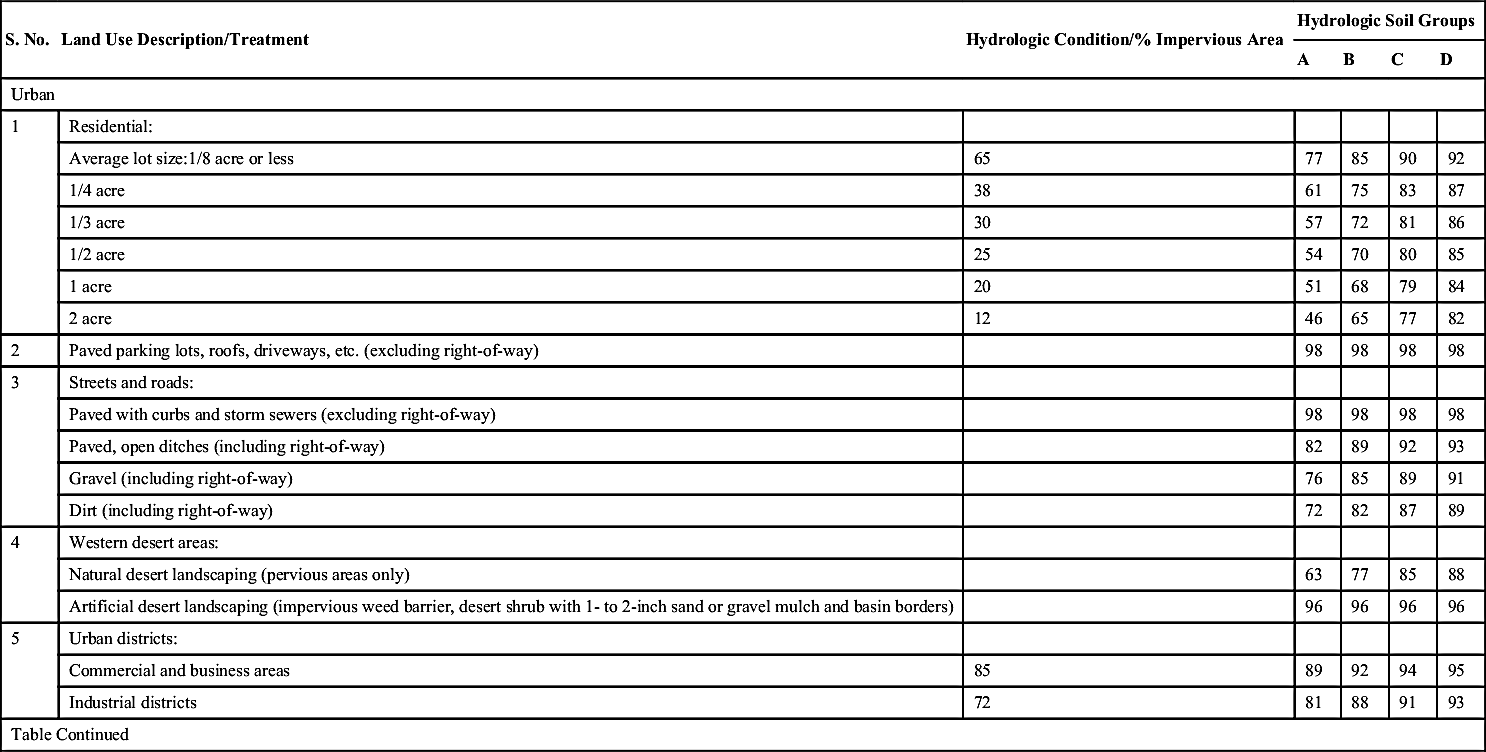
| S. No. | Land Use Description/Treatment | Hydrologic Condition/% Impervious Area | Hydrologic Soil Groups | |||
| A | B | C | D | |||
| 6 | Developing areas: | |||||
| Newly graded areas (pervious areas only, no vegetation) | 77 | 86 | 91 | 94 | ||
| Idle lands | ||||||
| 7 | Open spaces, lawns, parks, golf courses, cemeteries, etc. | |||||
| Grass cover on 75% or more of the area | Good | 39 | 61 | 74 | 80 | |
| Grass cover on 50%–75% of the area | Fair | 49 | 69 | 79 | 84 | |
| Agricultural | ||||||
| 8 | Cultivated lands: | |||||
| Fallow: | ||||||
| Bare soil: straight row | – | 77 | 86 | 91 | 94 | |
| Crop residue cover | Poor | 76 | 85 | 90 | 93 | |
| Good | 74 | 83 | 88 | 90 | ||
| 9 | Row crops: | |||||
| Straight row | Poor | 72 | 81 | 88 | 91 | |
| Straight row | Good | 67 | 78 | 85 | 89 | |
| Crop residue cover: straight row | Poor | 71 | 80 | 87 | 90 | |
| Crop residue cover: straight row | Good | 64 | 75 | 82 | 85 | |
| Contoured | Poor | 70 | 79 | 84 | 88 | |
| Contoured | Good | 65 | 75 | 82 | 86 | |
| Crop residue cover: contoured | Poor | 69 | 78 | 83 | 87 | |
| Crop residue cover: contoured | Good | 64 | 74 | 81 | 85 | |
| Contoured and terraced | Poor | 66 | 74 | 80 | 82 | |
| Contoured and terraced | Good | 62 | 71 | 78 | 81 | |
| Crop residue cover contoured and terraced | Poor | 65 | 73 | 79 | 81 | |
| Crop residue cover contoured and terraced | Good | 61 | 70 | 77 | 80 | |
| Table Continued | ||||||

| S. No. | Land Use Description/Treatment | Hydrologic Condition/% Impervious Area | Hydrologic Soil Groups | |||
| A | B | C | D | |||
| 10 | Small grain: | |||||
| Straight row | Poor | 65 | 76 | 84 | 88 | |
| Straight row | Good | 63 | 75 | 83 | 87 | |
| Crop residue cover straight row | Poor | 64 | 75 | 83 | 86 | |
| Crop residue cover straight row | Good | 60 | 72 | 80 | 84 | |
| Contoured | Poor | 63 | 74 | 82 | 85 | |
| Contoured | Good | 61 | 73 | 81 | 84 | |
| Crop residue cover contoured | Poor | 62 | 73 | 81 | 84 | |
| Crop residue cover: contoured | Good | 60 | 72 | 80 | 83 | |
| Contoured and terraced | Poor | 61 | 72 | 79 | 82 | |
| Contoured and terraced | Good | 59 | 70 | 78 | 81 | |
| Crop residue cover contoured and terraced | Poor | 60 | 71 | 78 | 81 | |
| Crop residue cover contoured and terraced | Good | 58 | 69 | 77 | 80 | |
| 11 | Close-seeded legumes or rotation meadow: | |||||
| Straight row | Poor | 66 | 77 | 85 | 89 | |
| Straight row | Good | 58 | 72 | 81 | 85 | |
| Contoured | Poor | 64 | 75 | 83 | 85 | |
| Contoured | Good | 55 | 69 | 78 | 83 | |
| Contoured and terraced | Poor | 63 | 73 | 80 | 83 | |
| Contoured and terraced | Good | 51 | 67 | 76 | 80 | |
| Uncultivated lands: | ||||||
| 12 | Pasture or range: | Poor | 68 | 79 | 86 | 89 |
| Fair | 49 | 69 | 79 | 84 | ||
| Good | 39 | 61 | 74 | 80 | ||
| Contoured | Poor | 47 | 67 | 81 | 88 | |
| Contoured | Fair | 25 | 59 | 75 | 83 | |
| Contoured | Good | 6 | 35 | 70 | 79 | |
| 13 | Meadow: continuous grass, protected from grazing, and generally mowed for hay | Good | 30 | 58 | 71 | 78 |
| Brush–brush weed grass mixture with brush being the major element | Poor | 48 | 67 | 77 | 83 | |
| Fair | 35 | 56 | 70 | 77 | ||
| Good | 30 | 48 | 65 | 73 | ||
| 14 | Farmsteads: buildings, lanes, driveways, and surrounding lots | – | 59 | 74 | 82 | 86 |
| Table Continued | ||||||

| S. No. | Land Use Description/Treatment | Hydrologic Condition/% Impervious Area | Hydrologic Soil Groups | |||
| A | B | C | D | |||
| Woods and Forests | ||||||
| 15 | Humid rangelands or agricultural uncultivated lands: | |||||
| Woods or forest land | Poor | 45 | 66 | 77 | 83 | |
| Fair | 36 | 60 | 73 | 79 | ||
| Good | 25 | 55 | 70 | 77 | ||
| 16 | Woods–grass combination (orchard or tree farm) | Poor | 57 | 73 | 82 | 86 |
| Fair | 43 | 65 | 76 | 82 | ||
| Good | 32 | 58 | 72 | 79 | ||
| 17 | Arid and semiarid rangelands: | |||||
| Herbaceous | Poor | 80 | 87 | 93 | ||
| Fair | 71 | 81 | 89 | |||
| Good | 62 | 74 | 85 | |||
| 18 | Oak-aspen | Poor | 66 | 74 | 79 | |
| Fair | 48 | 57 | 63 | |||
| Good | 30 | 41 | 48 | |||
| 19 | Pinyon-juniper | Poor | 75 | 85 | 89 | |
| Fair | 58 | 73 | 80 | |||
| Good | 41 | 61 | 71 | |||
| 20 | Sagebrush with grass understory | Poor | 67 | 80 | 85 | |
| Fair | 51 | 63 | 70 | |||
| Good | 35 | 47 | 55 | |||
| 21 | Desert shrub | Poor | 63 | 77 | 85 | 88 |
| Fair | 55 | 72 | 81 | 86 | ||
| Good | 49 | 68 | 79 | 84 | ||

Hydrological Soil Group (SCS, 1985)
Group A: The soils falling in Group A exhibit high infiltration rates even when they are thoroughly wetted, high rate of water transmission, and low runoff potential. Such soils include primarily deep, well to excessively drained sands or gravels.
Group B: These soils have moderate infiltration rates when thoroughly wetted and consist primarily of moderately deep to deep, moderately well drained to well-drained soils with fine, moderately fine, to moderately coarse textures, for example, shallow loess and sandy loam. These soils exhibit moderate rates of water transmission.
Group C: Soils in this group have low infiltration rates when thoroughly wetted. These soils primarily contain a layer that impedes downward movement of water. Such soils are of moderately fine to fine texture, for example, clay loams, shallow sandy loam, and soils low in organic content. These soils exhibit a slow rate of water transmission.
Group D: The soils of this group exhibit very low rates of infiltration when they are thoroughly wetted. Such soils are primarily clay soils of high swelling potential, soils with a permanent high water table, soils with a clay pan or clay layer at or near the surface, and shallow soils over nearly impervious material. These soils exhibit a very slow rate of water transmission.
Description of Hydrologic Groups (SCS, 1985)
Description of Hydrologic Conditions (SCS, 1985)
Description of Antecedent Moisture Conditions (SCS, 1985)
| AMC | Total 5-day Antecedent Rainfall (cm) | |
| Dormant Season | Growing Season | |
| I | <1.3 | <3.6 |
| II | 1.3–2.8 | 3.6–5.3 |
| III | >2.8 | >5.3 |
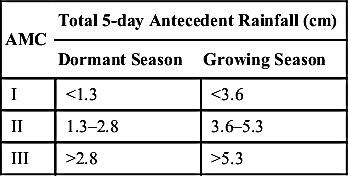
Conversion of the CNII values into CNI and CNIII.
where CNI and CNIII are the CN values corresponding to AMC I and AMC III.
A.9. General Guideline for Embankment Sections (7IS 12169, 1987)
| S. No. | Description | Height: <5 m | Height: 5–10 m | Height: 10–15 m | |||
| 1 | Type of section | Homogeneous/modified homogeneous section | Zoned/modified homogeneous/homogeneous section | Zoned/modified homogeneous/homogeneous section | |||
| 2 | Side slopes | U/S | D/S | U/S | D/S | U/S | D/S |
| (a) | Coarse grained soil | ||||||
| (i) GW, GP, SW, SP | Not suitable | Not suitable | Not suitable for core, suitable for casing zone | ||||
| (ii) GC, GM, SC, SM | 2:1 | 2:1 | 2:1 | 2:1 | Section to be decided based on stability analysis | ||
| (b) | Fine grained soil | ||||||
| (i) CL, ML, CI, MI | 2:1 | 2:1 | 2.5:1 | 2.25:1 | Section to be decided based on stability analysis | ||
| (ii) CH, MH | 2:1 | 2:1 | 3.75:1 | 2.5:1 | Section to be decided based upon stability analysis | ||
| 3. | Hearting zone | Not required | May be provided | Necessary | |||
| (a) Top width | – | 3 m | 3 m | ||||
| (b) Top level | – | 0.5 m above MWL | 0.5 m above MWL | ||||
| 4. | Rock toe height | Not necessary up to 3 m height. Above 3 m height, 1 m height of rock toe may be provided | Necessary = H/5 | Necessary = H/5 | |||
| 5. | Berms | Not necessary | Not necessary | The berm may be provided as per design. The minimum berm width shall be 3 m. | |||

A.10. 10-Daily Crop Coefficients For Major Crops Of Rabi And Kharif Seasons (Dimensionless)
| Crop | Crop | Wheat | Barley | Gram | Mustard | Rabi Fodder | Maize | Soybean | Groundnut | Jowar | Others |
| Month | Duration of crop | 130 | 130 | 141 | 130 | 182 | 102 | 130 | 130 | 115 | 140 |
| 10-Day/date of sowing | 16-Nov. | 07-Nov. | 21-Oct. | 16-Oct. | 16-Oct. | 01-Jul. | 01-Jul. | 01-Jul. | 01-Jul. | 01-Jul. | |
| Oct. | I | 0.6 | 1.05 | 1.05 | 0.75 | 0.75 | |||||
| Oct. | II | 0.1 | 0.5 | 0.5 | 0.9 | 0.9 | 0.6 | 0.6 | |||
| Oct. | III | 0.1 | 0.1 | 0.66 | 0.75 | 0.75 | 0.5 | 0.5 | |||
| Nov. | I | 0.2 | 0.3 | 0.2 | 0.65 | 0.2 | 0.2 | ||||
| Nov. | II | 0.2 | 0.2 | 0.8 | 0.54 | 0.65 | |||||
| Nov. | III | 0.3 | 0.75 | 0.8 | 0.54 | 0.85 | |||||
| Dec. | I | 0.75 | 0.75 | 1.05 | 0.9 | 0.9 | |||||
| Dec. | II | 0.84 | 0.75 | 1.1 | 0.95 | 0.8 | |||||
| Dec. | III | 1.05 | 0.75 | 1.1 | 1 | 0.6 | |||||
| Jan. | I | 1.15 | 1.05 | 1.1 | 1.1 | 0.8 | |||||
| Jan. | II | 1.15 | 1.15 | 1.05 | 1.15 | 0.65 | |||||
| Jan. | III | 1.15 | 0.65 | 0.8 | 0.9 | 0.54 | |||||
| Feb. | I | 1.15 | 0.65 | 0.55 | 0.8 | 0.8 | |||||
| Feb. | II | 1.15 | 0.65 | 0.55 | 0.6 | 0.65 | |||||
| Feb. | III | 0.9 | 0.25 | 0.25 | 0.4 | 0.6 | |||||
| Mar. | I | 0.84 | 0.2 | 0.85 | |||||||
| Mar. | II | 0.4 | 0.2 | 0.75 | |||||||
| Mar. | III | 0.2 | 0.6 | ||||||||
| Apr. | I | 0.85 | |||||||||
| Apr. | II | 0.75 | |||||||||
| Table Continued | |||||||||||

| Crop | Crop | Wheat | Barley | Gram | Mustard | Rabi Fodder | Maize | Soybean | Groundnut | Jowar | Others |
| Apr. | III | ||||||||||
| May | I | ||||||||||
| May | II | ||||||||||
| May | III | ||||||||||
| Jun. | I | ||||||||||
| Jun. | II | ||||||||||
| Jun. | III | ||||||||||
| Jul. | I | 0.12 | 0.12 | 0.12 | 0.12 | 0.12 | |||||
| Jul. | II | 0.4 | 0.12 | 0.12 | 0.22 | 0.22 | |||||
| Jul. | III | 0.76 | 0.12 | 0.12 | 0.35 | 0.34 | |||||
| Aug. | I | 1.15 | 0.5 | 0.5 | 0.7 | 0.71 | |||||
| Aug. | II | 1.15 | 0.7 | 0.7 | 0.72 | 0.82 | |||||
| Aug. | III | 1.15 | 0.9 | 0.9 | 0.75 | 0.93 | |||||
| Sep. | I | 1.05 | 1.05 | 1.05 | 1 | 1.04 | |||||
| Sep. | II | 0.9 | 1.05 | 1.05 | 1.05 | 1.01 | |||||
| Sep. | III | 0.72 | 1.05 | 1.05 | 1.05 | 0.97 |
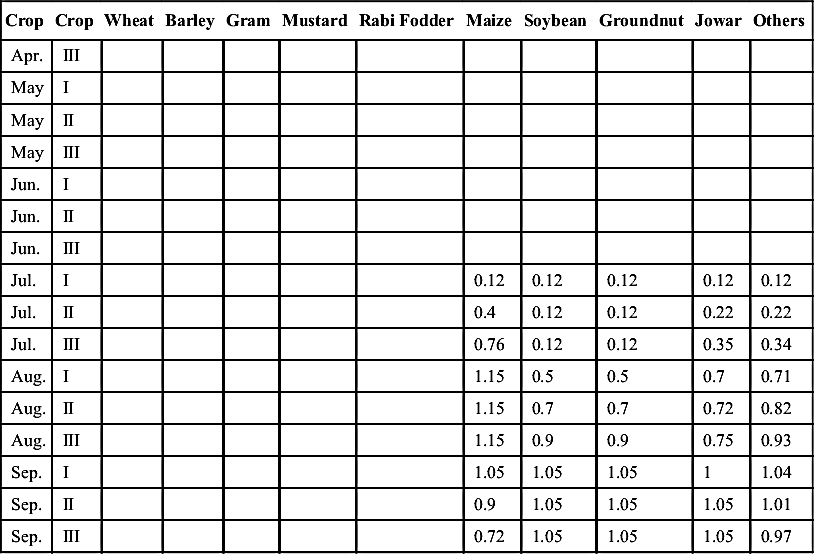
A.11. Field Capacity and Permanent Wilting Point
A.12. Values of Maximum Allowable Deficit and Root Depth of Crops
| S. No. | Crop | MAD (%) | Maximum Root Depth (cm) |
| 1 | Maize | 65 | 60–90 |
| 2 | Pasture | 65 | 45–60 |
| 3 | Peas | 65 | 50–60 |
| 4 | Potato | 30 | 50–60 |
| 5 | Sorghum | 65 | 60–90 |
| 6 | Soybean | 65 | 80–100 |
| 7 | Wheat | 65 | 90–120 |
| 8 | Sugarcane | 60 | 70–95 |
| 9 | Barley | 55 | 90–100 |
| 10 | Cotton | 65 | 120–150 |
| 11 | Groundnut | 50 | 60–75 |
| 12 | Gram | 45 | 120–150 |
| Table Continued | |||
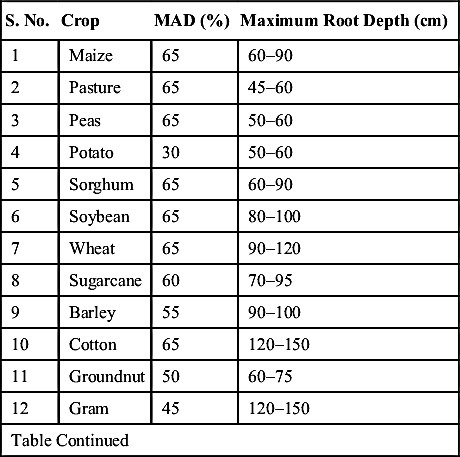
| S. No. | Crop | MAD (%) | Maximum Root Depth (cm) |
| 13 | Mustard | 60 | 120–150 |
| 14 | Paddy | 20 | 30–60 |
| 15 | Pearl millet (Bajra) | 55 | 60–90 |
| 16 | Pigeon pea (Arhar/Tur) | 70 | 120–150 |

A.13. Approximate Net Irrigation Depth Applied per Irrigation (mm)
A.14. Recommended Value of Irrigation Application Rate
..................Content has been hidden....................
You can't read the all page of ebook, please click here login for view all page.




